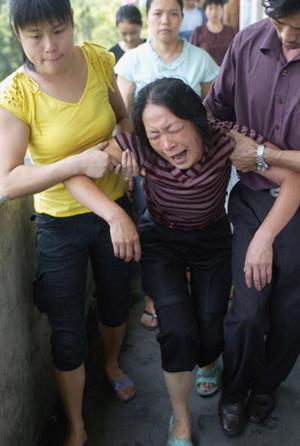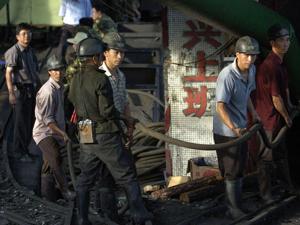Seven days after the Guangdong Daxing coalmine accident, there are still 123 miners stranded in the mine and their chance of survival is slim.
This tragedy has allowed people to see the sad situation where miners, who are compelled to risk their lives to provide for their families, are forced to suffer due to the mine owners' “sacrificing morality for profit.” Such frequent mine accidents result from the close relationships and collusion between the owners and government officials, leading to poor supervision.
According to the Ming Pao Daily, the words “energy shortage” have become a popular phrase this past year in Mainland China. Coal provides 74 percent China’s total energy output, and the price of coal has skyrocketed due to increased demands. But the supply is not sufficient to satisfy the demand, so many coal mines, eager to take advantage of a sellers’ market, mine recklessly, even at the risk of the miners' lives.
A Calamity Caused by Overproduction

According to a villager in Huanghuai town, where the accident occurred, the local coal price has increased 100 percent, from 200 to 400 yuan per ton, in just two years. The local mine worked aggressively to profit from this price increase.
Enticed by the opportunity for profit, the production of many coal mines has been pushed to exceed their capacities. A document from the National Safe Production Surveillance Administration Bureau revealed that about one-third of the state-owned mines in China exceed their safe production capacity at the current time.
A report on the Daxing coalmine, where the accident occurred, states that it was originally designed to produce 30,000 tons of coal per year. But a miner named Chen said that the mine currently produces over 400 tons daily, which is nearly 70,000 tons every six months. The number of miners the mine can safely hold is limited. Such excessive production forces more miners to crowd into the narrow mine shafts, which greatly increases injuries when accidents occur. At the time of the Daxing mine accident, there were more than 100 miners working, which greatly exceeded the mine's appraised safety limit.
Businessmen Collude with Government Officials
Reports from the area also state that the local officials' ownership of coalmine shares is an open secret. A few days ago, the Guangdong Province Disciplinary Inspection Commission and the Provincial Supervision Hall released a notice stating that most of the 65 owners of the Daxing mine were representatives of the Xingning City People's Congress. The mine's Chairman of the Board, Zeng Yungao, was a representative from both Meizhou City and Xingning City People's Congresses. The two Vice-Chairmen, Zeng Guixiang and Zeng Fanjin, were commissioners of the Political Consultants Committee of Guangdong Province and Meizhou City, respectively. The Vice-Chairman of another coal mine, Zeng Wenkun, was also a representative from the Xingning City People's Congress.
A villager named Ling said that in Huanghuai Town, each mine had several shareholders, and that only influential people could own shares. A mine could have a few dozen and even as few as five or six shareholders. Some village officials invested 20,000 to 30,000 yuan at the beginning of the year and expected to receive nearly 1 million yuan by the year's end.
Obviously there is a close relationship, based on profit, between some village officials, law enforcement personnel and the mine owners. The mine's security supervision and management systems were only nominal and not enforced. Intent on profit, some officials ignored the illegal mining practices, thus increasing the likelihood of mining accidents.
There are also reports that although the Daxing coal mine fails to meet safe mining standards, a “safe production permit” was still obtained during its reconstruction period. The collusion between the business and government officials is an open secret, and a mine owner can obtain the proper permits through bribery.
More than 90 percent of the miners working in the Daxing coal mine come from the relatively poor rural areas of Jiangxi, Hunan, Guizhou and Sichuan Provinces. To support their families, these miners have no other choice but to risk their lives working at the Daxing mine.
Rescue Efforts Are Suspected to Be “Just For Show”
News media in Hong Kong report that an engineer who had come to the accident site to provide assistance with the rescue, indicated that the conditions in the mine were chaotic and unstable, and that although they have searched for days, the rescue effort has been futile.
Authorities received the approximately 800 miners' family members very “attentively,” meaning that they were kept under strict supervision and settled in hotels in Xingning City, about 30 kilometers from the mine, and every family had a group of four people to “care for” them (so that the families would not discover the true situation).
However, Mr. Zhou, a family member from Hunan province, indicated yesterday that the reason the authorities were “meticulously caring” for the families was to prevent the press from interviewing the victims' families. He said, “They actually meant to put us under house arrest.”
Another miner's family member, Mr. Xie, also from Hunan, was dissatisfied with the rescue effort, pointing out that the authorities botched the rescue effort by placing the main water pump at the Daxing mine, which had 36 stranded miners, but placing a much smaller pump at the Yongfeng mine, which had a greater number of stranded miners.
Mr. Xie wondered if the authorities had focused the press on the rescue efforts for Daxing mine in order to “make a show to the outside audience.” He confided that everyone tacitly agreed the miners' chances of survival were near zero, yet the authorities continued delaying discussion of compensation with the families.




